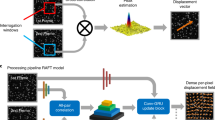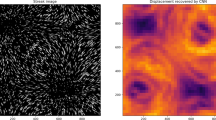Abstract
Velocity field quantification for high-speed flows is of fundamental importance to understand flow dynamics, turbulence, and flow–structure interactions. Optical velocimetry techniques commonly provide sparse information in the flows. Dense fields of velocity vectors with high spatial resolutions are indispensable for detailed analysis of complex motion patterns and accurate motion tracking within the field of view. In the present work, two-dimensional (2D) Rayleigh scattering imaging (RSI) at a rate of 10- to 100-kHz was utilized to quantify the high-speed flow velocity by employing deep learning-based optical flow analysis, along with density and temperature fields from Rayleigh scattering intensity profiles. High-speed Rayleigh scattering images are highly spatially resolved, have smooth gradients without intensity discontinuities, and precisely track key features of the flows. The deep learning-based optical flow method utilizes recurrent neural network architecture to extract the per-pixel features of both input images, calculate correlation from all pairs of the features, and get training by recurrently updating the optical flow. 2D instantaneous velocity fields of both nonreacting and reacting flows measured by RSI were obtained from deep learning-based optical flow analysis, thus extending RSI as a non-intrusive, nonseeded, and multiscalar measurement technique of high-speed nonreacting and reacting flows.
Graphical abstract








Similar content being viewed by others
References
Adrian RJ (2005) Twenty years of particle image velocimetry. Exp Fluids 39(2):159–169
Bork B, Böhm B, Heeger C, Chakravarthy SR, Dreizler A (2010) 1D high-speed Rayleigh measurements in turbulent flames. Appl Phys B Lasers Opt 101:487–491
Brunton SL, Noack BR, Koumoutsakos P (2020) Machine learning for fluid mechanics. Annu Rev Fluid Mech 52(1):477–508
Buch KA, Dahm WJA (1998) Experimental study of the fine-scale structure of conserved scalar mixing in turbulent shear flows. Part 2. Sc[ap]1. J Fluid Mech 364:1–29
Eslami N, Arefi F, Mansourian AM, Kasaei S (2024) Rethinking RAFT for efficient optical flow. arXiv preprint arXiv:2401.00833
Feikema DA, Everest D, Driscoll JF (1996) Images of dissipation layers to quantify mixing within a turbulent jet. AIAA J 34(12):2531–2538
Frank JH, Kaiser SA (2008) High-resolution imaging of dissipative structures in a turbulent jet flame with laser Rayleigh scattering. Exp Fluids 44(2):221–233
Frank JH, Kaiser SA (2010) High-resolution imaging of turbulence structures in jet flames and non-reacting jets with laser Rayleigh scattering. Exp Fluids 49(4):823–837
Frank JH, Kaiser SA, Oefelein JC (2011) Analysis of scalar mixing dynamics in LES using high-resolution imaging of laser Rayleigh scattering in turbulent non-reacting jets and non-premixed jet flames. Proc Combust Inst 33:1373–1381
Grib SW, Jiang N, Hsu PS, Danehy PM, Roy S (2019) Rayleigh-scattering-based two-dimensional temperature measurement at 100-kHz frequency in a reacting flow. Opt Express 27(20):27902–27916
Horn BKP, Schunck BG (1981) Determining optical flow. Artif Intell 17(1):185–203
Hur J, Roth S (2020) Optical flow estimation in the deep learning age. Model Hum Motion Hum Percept Robot Des 119–140
Jiang N, Hsu PS, Mance JG, Wu Y, Gragston M, Zhang Z, Miller JD, Gord JR, Roy S (2017) High-speed 2D Raman imaging at elevated pressures. Opt Lett 42(18):3678–3681
Jin X, Laima S, Chen W-L, Li H (2020) Time-resolved reconstruction of flow field around a circular cylinder by recurrent neural networks based on non-time-resolved particle image velocimetry measurements. Exp Fluids 61(4):114
Kaiser SA, Frank JH (2011) The effects of laser-sheet thickness on dissipation measurements in turbulent non-reacting jets and jet flames. Meas Sci Technol 22:045403
Laima S, Zhou X, Jin X, Gao D, Li H (2023) DeepTRNet: Time-resolved reconstruction of flow around a circular cylinder via spatiotemporal deep neural networks. Phys Fluids 35(1)
Mayer N, Ilg E, Hausser P, Fischer P, Cremers D, Dosovitskiy A, Brox T (2016) A large dataset to train convolutional networks for disparity, optical flow, and scene flow estimation. In: Proceedings of the IEEE Conference on Computer Vision and Pattern Recognition
Miles RB, Lempert WR, Forkey JN (2001) Laser Rayleigh scattering. Meas Sci Technol 12(5):R33
Padhee S, Johnson M, Yi H, Banerjee T, Yang Z (2022) Machine learning for aiding blood flow velocity estimation based on angiography. Bioengineering 9(11):622
Raissi M, Yazdani A, Karniadakis GE (2020) Hidden fluid mechanics: learning velocity and pressure fields from flow visualizations. Science 367(6481):1026–1030
Schneider C, Dreizler A, Janicka J, Hassel E (2003) Flow field measurements of stable and locally extinguishing hydrocarbon-fuelled jet flames. Combust Flame 135:185–190
Shi X, Huang Z, Li D, Zhang M, Cheung KC, See S, Qin H, Dai J, Li H (2023) Flowformer++: masked cost volume autoencoding for pretraining optical flow estimation. In: Proceedings of the IEEE/CVF Conference on Computer Vision and Pattern Recognition
Slipchenko MN, Miller JD, Roy S, Gord JR, Danczyk SA, Meyer TR (2012) Quasi-continuous burst-mode laser for high-speed planar imaging. Opt Lett 37(8):1346–1348
Su LK, Clemens NT (1999) Planar measurements of the full three-dimensional scalar dissipation rate in gas-phase turbulent flows. Exp Fluids 27:507–521
Su LK, Clemens NT (2003) The structure of fine-scale scalar mixing in gas-phase planar turbulent jets. J Fluid Mech 488:1–29
Sui X, Li S, Geng X, Wu Y, Xu X, Liu Y, Goh R, Zhu H (2022) Craft: cross-attentional flow transformer for robust optical flow. In: Proceedings of the IEEE/CVF Conference on Computer Vision and Pattern Recognition
Teed Z, Deng J (2020) Raft: Recurrent all-pairs field transforms for optical flow. In: Computer Vision–ECCV 2020: 16th European Conference, Glasgow, UK, August 23–28, 2020, Proceedings, Part II 16. 2020. Springer
Wang GH, Clemens NT, Varghese PL (2005a) High-repetition rate measurements of temperature and thermal dissipation in a non-premixed turbulent jet flame. Proc Combust Inst 30(1):691–699
Wang GH, Clemens NT, Varghese PL (2005b) Two-point, high-repetition-rate Rayleigh thermometry in flames: techniques to correct for apparent dissipation induced by noise. Appl Opt 44(31):6741–6751
Wang GH, Clemens NT, Barlow RS, Varghese PL (2007) A system model for assessing scalar dissipation measurement accuracy in turbulent flows. Meas Sci Technol 18(5):1287–1303
Xu H, Zhang J, Cai J, Rezatofighi H, Tao D (2022) Gmflow: learning optical flow via global matching. In: Proceedings of the IEEE/CVF conference on computer vision and pattern recognition
Author information
Authors and Affiliations
Corresponding author
Additional information
Publisher's Note
Springer Nature remains neutral with regard to jurisdictional claims in published maps and institutional affiliations.
Rights and permissions
Springer Nature or its licensor (e.g. a society or other partner) holds exclusive rights to this article under a publishing agreement with the author(s) or other rightsholder(s); author self-archiving of the accepted manuscript version of this article is solely governed by the terms of such publishing agreement and applicable law.
About this article
Cite this article
Zhang, D., Yang, Z. Deep learning-based optical flow analysis of two-dimensional Rayleigh scattering imaging of high-speed flows. J Vis (2024). https://doi.org/10.1007/s12650-024-00978-y
Received:
Revised:
Accepted:
Published:
DOI: https://doi.org/10.1007/s12650-024-00978-y




